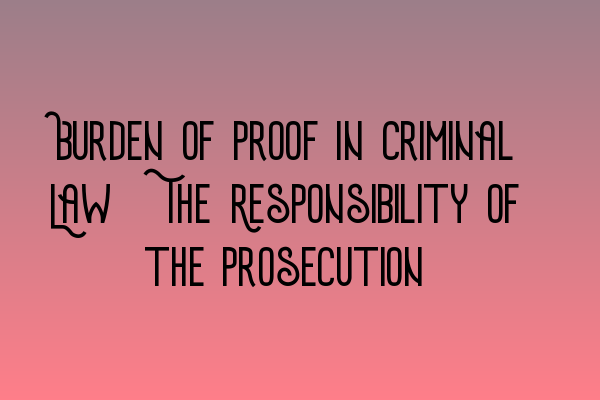Burden of Proof in Criminal Law: The Responsibility of the Prosecution
When it comes to criminal law, the burden of proof rests squarely on the prosecution. This means that the prosecution has the responsibility to prove that the defendant is guilty beyond a reasonable doubt. In this blog post, we will delve into the concept of burden of proof, its significance in criminal law cases, and the strategies that the prosecution employs to meet this burden.
Understanding the Burden of Proof
The burden of proof is a legal principle that places the responsibility on the prosecution to prove each and every element of the crime charged beyond a reasonable doubt. This is a high standard, as it requires the prosecution to present evidence that is so convincing that there is no reasonable doubt in the minds of the jurors or the judge.
As the burden of proof lies with the prosecution, the defendant is presumed innocent until proven guilty. This reflects the fundamental principle of criminal law that it is better for ten guilty individuals to go free than for one innocent person to be wrongfully convicted.
Significance of the Burden of Proof in Criminal Law
The burden of proof is of utmost importance in criminal law as it ensures that the accused is given a fair trial. It protects individuals from being falsely accused and convicted of crimes they did not commit. The burden lies with the prosecution as they are the party bringing the charges and seeking to punish the accused.
It is essential for the burden of proof to be met beyond a reasonable doubt to secure a conviction. This provides a safeguard against wrongful convictions and ensures that guilt is established with a high degree of certainty.
Prosecution Strategies to Meet the Burden of Proof
To meet the burden of proof, the prosecution employs various strategies, including:
- Presenting eyewitness testimony: Eyewitness testimony can be a powerful tool in establishing guilt. The prosecution will call witnesses who can provide firsthand accounts of the crime and identify the defendant as the perpetrator.
- Introducing physical evidence: Physical evidence such as DNA, fingerprints, or weapons can provide strong proof of the defendant’s involvement in the crime.
- Using expert witnesses: Expert witnesses who are qualified in their respective fields can provide specialized knowledge or opinions that support the prosecution’s case.
- Providing circumstantial evidence: Circumstantial evidence, although indirect, can be used to build a case against the defendant. The prosecution will connect the dots and present a compelling narrative that points to the defendant’s guilt.
In conclusion, the burden of proof in criminal law rests on the prosecution, requiring them to prove the defendant’s guilt beyond a reasonable doubt. It is a crucial aspect of ensuring a fair trial and protecting the rights of the accused. By employing various strategies, such as presenting eyewitness testimony, introducing physical evidence, utilizing expert witnesses, and providing circumstantial evidence, the prosecution strives to meet this burden. To learn more about criminal law and the solicitor’s qualifying examination, check out these related articles:
- SQE Exam Prep: Essential Study Materials for Aspiring Solicitors
- Demystifying the Solicitors Qualifying Examination Format
- SQE Exam for International Lawyers: Challenges and Success Strategies
- LLC Formation Made Simple: Step-by-Step Guide for UK Entrepreneurs
- LLC Formation: A Step-by-Step Guide for UK Entrepreneurs
